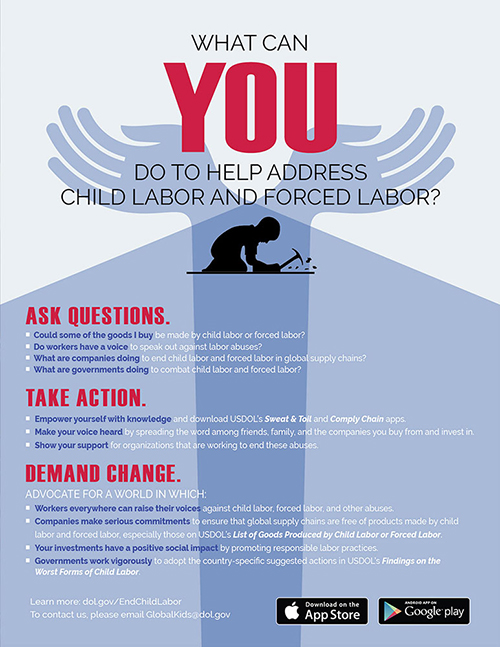List of Goods Produced by Child Labor or Forced Labor
The Bureau of International Labor Affairs (ILAB) maintains a list of goods and their source countries which it has reason to believe are produced by child labor or forced labor in violation of international standards, as required under the Trafficking Victims Protection Reauthorization Act (TVPRA) of 2005 and subsequent reauthorizations. The List of Goods Produced by Child Labor or Forced Labor comprises 159 goods from 78 countries and areas, as of September 28, 2022.
ILAB maintains the List primarily to raise public awareness about forced labor and child labor around the world and to promote efforts to combat them; it is not intended to be punitive, but rather to serve as a catalyst for more strategic and focused coordination and collaboration among those working to address these problems.
Publication of the List has resulted in new opportunities for ILAB to engage with foreign governments to combat forced labor and child labor. It is also a valuable resource for researchers, advocacy organizations and companies wishing to carry out risk assessments and engage in due diligence on labor rights in their supply chains.
The countries on the List span every region of the world. The most common agricultural goods listed are sugarcane, cotton, coffee, tobacco, cattle, rice, and fish. In the manufacturing sector, bricks, garments, textiles, footwear, carpets, and fireworks appear most frequently. In mined or quarried goods, gold, coal and diamonds are most common.
ILAB published the initial TVPRA List in 2009 and updated it annually through 2014, following a set of procedural guidelines that were the product of an intensive public consultation process. ILAB now updates and publishes the List every other year, pursuant to changes in the law.
Procedural Guidelines
On January 25, 2024, ILAB's Office of Child Labor, Forced Labor, and Human Trafficking published Procedural Guidelines for the development and maintenance of the List of Goods from countries produced by child labor or forced labor in violation of international standards.
| Country/Area | Good | Exploitation Type |
|---|---|---|
| Bangladesh | Child Labor | |
| Brazil | Child Labor | |
| China | Forced Labor | |
| India | Child Labor | |
| Turkey (Türkiye) | There are reports that children as young as 9 produce footwear in Türkiye. Both boys and girls, including many in the Syrian refugee community, are engaged in work activities in this sector. According to international organizations, NGOs, and media sources, there is credible evidence that the use of child labor is common in footwear production, including in major production areas such as Gaziantep and Istanbul. Children work long hours, with some reports of working up to 12 hours per day, 6 days per week. Due to the long hours worked, many child workers in this sector are unable to attend school. Some child laborers in this sector use hazardous chemicals, machinery, and materials. |
Child Labor |
| Vietnam | There is evidence that children ages 5 to 17 in Vietnam manufacture footwear. Based on the Government of Vietnam’s National Child Labor Survey 2012, the results of which were published in 2014, an estimated 9,756 child laborers work in footwear manufacturing for over 42 hours per week. Approximately 2.2 percent, or 215, of the total number of child laborers who manufacture footwear for over 42 hours per week are 12-14 years old, while 97.8 percent, or 9,541, are 15-17 years old. The survey considers a child to be engaged in child labor if the child is working an excessive number of hours per week for his or her age, or if the child is engaged in work that is prohibited for underage employees according to national legislation. |
Child Labor |
| Indonesia | Child Labor |
your hand? Download ILAB's Sweat & Toil App today!
Are you a company looking to fight child labor and forced labor in supply
chains?





